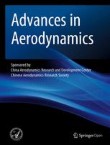Advances in Aerodynamics is affiliated with the with Computational Aerodynamics Institute, China Aerodynamics Research and Development Cernter and Chinese Aerodynamics Research Society.
Oblique-mode breakdown in hypersonic and high-enthalpy boundary layers over a blunt cone
The nonlinear analyses of the hypersonic and high-enthalpy boundary-layer transition had received little attention compared with the widely-studied linear instabilities. In this work, the oblique-mode breakdow...
